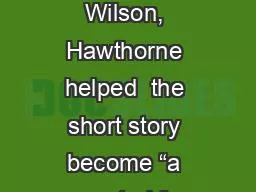

of literature to which he added morals and lessons 294 Hawthorne is also remembered for helping to establish the short story as a respected form of literature and as a proponent of instilling morals and lessons into his writing Wilson 294 ID: 802017
Download The PPT/PDF document "According to Wilson, Hawthorne helped t..." is the property of its rightful owner. Permission is granted to download and print the materials on this web site for personal, non-commercial use only, and to display it on your personal computer provided you do not modify the materials and that you retain all copyright notices contained in the materials. By downloading content from our website, you accept the terms of this agreement.
Slide1
According to Wilson, Hawthorne helped the short story become “a respected form of literature”, to which he added “morals and lessons” (294).
“Hawthorne is also remembered for helping to establish the short story as a respected form of literature and as a proponent of instilling morals and lessons into his writing” (Wilson 294).
Slide2Critics have focused on Faith’s pink ribbons more than any of the story’s other symbols (Wilson 297).Wilson indicates that critics have focused on Faith’s pink ribbons more than any of the story’s other symbols
(
297).
“
The pink ribbons that decorate Faith’s cap have drawn more critical attention than any other symbol in the story” (Wilson 297).
Slide3As the story ends, Brown has rejected his wife, thereby symbolizing the author’s “belief in the isolation of the human spirit” (Wilson 298).Wilson views Brown’s rejection of his wife as a symbol of “Hawthorne’s belief in the isolation of the human spirit” (298).
“By turning away [from his wife], Brown becomes the symbolic representation of Hawthorne’s belief in the isolation of the human spirit” (Wilson 298).
Slide4While Faith is able to overlook the “fallen nature of humanity,” Brown cannot, and so remains an “absolutist…stuck in a state of suspicion and ill feelings” (Wilson 298).
“Whereas Faith is able to accept the inevitable fallen nature of humanity and live prosperously within this realization, Brown the absolutist cannot accept this truth, and remains stuck in a state of suspicion and ill feelings” (Wilson 298).
Slide5The reader is never told explicitly the nature of Brown’s journey into the forest, but most critics view it as “a deliberate quest of sin” (Connolly 309).
“The errand on which he [Brown] is going is presented mysteriously and is usually interpreted to be a deliberate quest of sin” (Connolly 309).
Slide6Brown’s three-month-old marriage to Faith could be viewed as “the moment of conversion to grace in which he became fairly sure of his election to Heaven” (Connolly 309).
Connolly suggests that Brown’s three-month-old marriage to Faith represents Brown’s “moment of conversion to grace,” where he becomes confident that he will be one of the elect (309).
.
“Young Goodman Brown has been married to his Faith for only three months. Either the allegory breaks down at this point or the marriage to Faith must be looked upon as the moment of conversion to grace in which he became fairly sure of his election to Heaven” (Connolly 309).
Slide7Gordon and Tate have identified the theme of the story as “the unhappiness which the human heart suffers as a result of its inner depravity” (qtd
. in Connolly 308-09).
The theme is one common to Hawthorne: “the unhappiness which the human heart suffers as a result of its inner depravity
” (
qtd
. in Connolly 308-309).
. According to Gordon and Tate, “Hawthorne is dealing with his favorite theme: the unhappiness which the human heart suffers as a result of its inner depravity” (qtd. in Connolly 308-09).
Slide8In “Young Goodman Brown,” Hawthorne criticizes Calvinism, implying that the doctrine of the elect, rather than saving man, actually condemns him by negating the possibility of salvation (Connolly 310).
“This story is Hawthorne’s criticism of the teachings of Puritanic Calvinism. His implication is that the doctrine of the elect and damned is not a faith which carries man heavenward, as Brown once believed, but, instead, condemns him to hell – bad and good alike and indiscriminately – and for all intents and purposes so few escape as to make man’s chance of salvation almost disappear” (Connolly 310).
Slide9Works
Cited
Connolly, Thomas E.
“Hawthorne’s ‘Young Goodman Brown’: An Attack on Puritanic
Calvinism.”
American Literature
, 3 November 1956, pp. 370-375.
Short Stories for
Students: Vol. 1,
edited by Kathleen Wilson, Gale, 1997, pp. 308-311.
Wilson, Kathleen, ed. “Young Goodman Brown.”
Short Stories for Students: Vol.
1,
Gale
,
1997, pp. 294-311
.